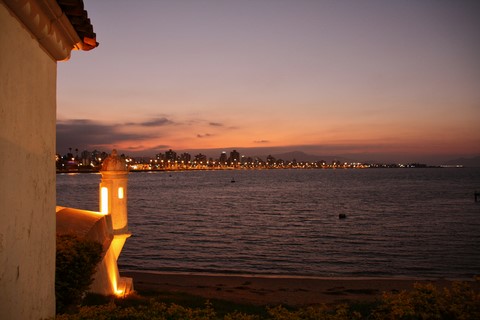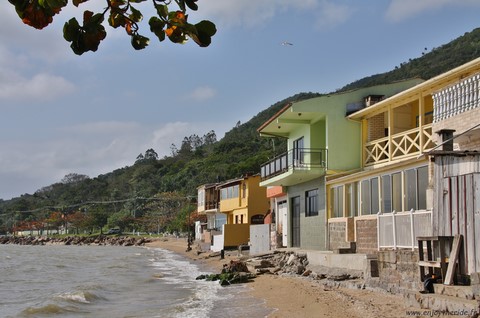Florianópolis
You can click on pictures to enlarge them
It is located South of the country, in the State of Santa Catarina which looks like the Old Continent. And for good reason: many immigrants coming from Northern Europe and Slavic countries settled there in the early 20th century. It still shows nowadays on some buildings, some houses, most of the population, and traditions. Moreover, landscapes bear a striking resemblance to Northern Europe and Central Europe: forests, lakes and mountains abound, except that they are planted with palm trees and close to beaches and lagoons. An exotic Europe, in some kind of way. Yet, that region of Brazil, wealthy and prosperous, is unknown on our side of the Atlantic Ocean, whereas it is one of the most visited in the country.
The city center
Florianópolis is a city of 420 000 inhabitants. It is straddling Santa Catarina Island and the continent to which it is linked by highway bridges and the superb Hercílio Luz Bridge. Very colored, clean and safe, «Floripa» immediately appealed to us. There, we get a sense of well-being and it is a great place to live. And what a joy to be able at last to get our cameras and tripods out without being on alert, even at night!.. Finally, its carnival is one of the most famous in the South.
Praça 15 de Novembro, shaded by enormous trees, is the hub of the city. Artists come to perform regularly. The Catedral Metropolitana rises nearby, like the Museu Histórico de Santa Catarina, which displays its coral colored façades adorned with bright white. It dates from the 18th century and was the Governor's residence in the mid 20th century. It is possible to visit the apartments on the 2nd floor. Be careful! Cloth pads are compulsory so that you do not damage the polished floor. Naturally, they are supplied at the admission. The ground floor houses exhibitions. The Church Nossa Senhora do Rosario e São Benedito, from the same period, stands on top of the Escadaria do Rosario.
The Largo de Alfândega is very pleasant, lively and popular. It has many restaurants, but it is mainly the superb Municipal Market from the 19th century which is worth a visit. It offers a wide variety of products. The city has some forts from the 18th century, among others the Forte Santana (photo) very close to the Hercílio Luz Bridge.
The seafront looks like more or less California with its pier, its cycle lanes and its pedestrian walkways, its grasses where some musicians come to perform. However, it is covered with buildings. Nevertheless, it is pleasant to live there. Nearby, Parque da Luz, haven of coolness and greenery, displays its strange totems at the entrance.
The beaches
The city center is lively all week long, but it is often neglected in favor of beaches for the weekend. Indeed those last mentioned are the real attraction in Floripa. Large, wild for most of them and beautiful, the ones that are directly located at the Atlantic Ocean (East Coast) are the most remarkable. Nevertheless the ones that face the continent are not outdone: they offer peaceful and authentic settings, but provide few opportunities for swimming, which is the reason why they have less success. Many hikes are provided through dunes, lagoons and forests, notably the remains of the Atlantic Forest.
In the center of the island, the Lagoa da Conceição, large lagoon, offers very varied landscapes: a still and smooth water, small pontoons some of which are surrounded by rowboats, grasses, groves, dunes... Kite surf is practiced on windy days. The Church Nossa Senhora da Conceição with its silver bell overlooks the village. The Costa de Lagoa is a preserved and idyllic place that can only be reached on foot or by boat. Many sea shuttles (every 30 minutes) allow you to get there.
On the Atlantic Coast, Barra de Lagoa enchants thanks to its fishing village. Joaquina beach, with its impressive rocks, its dunes and its turquoise water, is much appreciated by surfers because of its powerful waves. Besides, a championship takes place there. Sand board is practiced as well on dunes. Surfers like also to ride on the waves of Praia Mole, the same as body boarders, the best of whom come to participate in the final event of the national championship. Beach parties are frequent too. According to naturists, they gather in Praia Galheta.
Further South is located Armação, former whales fishers' beach converted into a cetacean observation site (Projeto Baleia Franca). It is also the starting point to reach Campeche Island, divers' paradise. Anyone who is passionate about history will surely be interested in rock paintings more than 5000 years old. Praia do Campeche is itself a very large and wild beach, the same as Praia Saquinho that you reach on foot from Praia Solidão. Finally, the aptly named Praia dos Naufragados can only be reached by a nice path with a lush greenery. It is beautiful and the spectacle of its stormy waters is breathtaking. Generally, waves on the East Coast are rather dangerous for swimming, so watch out!
Further North, still on the Atlantic side, Moçambique is more quiet but as much beautiful. It is often deserted and consequently not supervised. Surfers invite themselves there too. On Praia dos Ingleses, so named because of the English who stranded there in the 18th century, body board is practiced.
The West Coast is less appreciated by tourists, except Canasvieiras, North of the island, which welcomes among others vacationers from other countries in Southern America, even though they have been less numerous in recent times. Praia de Forte, which owes its name to the São José Fortress, enjoys nice very colored façades from the Colonial period.
Small traditional fishing villages in Baia Norte display colored façades with an Azorean touch. Beautiful coves stand in the middle of still waters. Oyster farming and shellfish farming are practiced. Besides, be aware that Floripa is the first oysters producer in the country. The small village of Sambaqui is very quiet and surrounded by small beaches. Santo Antônio de Lisboa was built by immigrants from the Azores who kept their traditions. The Church Nossa Senhora das Necessidades, in Colonial style, dates from the mid 18th century. Numerous restaurants have seafood. Its sunsets are well known to be the most beautiful in Santa Catarina Island. You can admire them directly from the beach, or from terraces and pontoons.
In the South, Ribeirão da Ilha (photo) is a timeless oyster farming village full of charm. Shrimps are fished as well. We lingered there a long time because that place is idyllic and absolutely calm. Its coves and its big rocks blend into a landscape made of turquoise water and greenery, adorned by small pastel colored wooden houses and small pontoons. The village is also famous for its Ethnological Museum.
Published on April, 27th 2016





